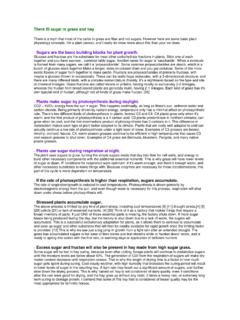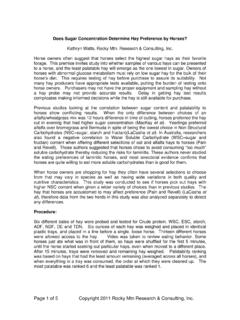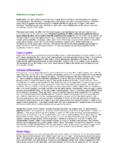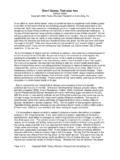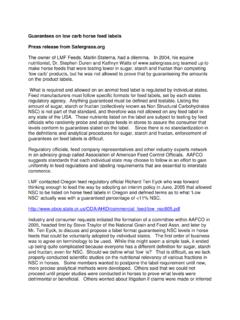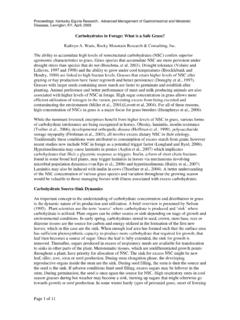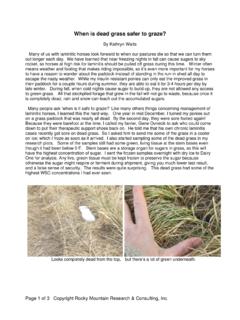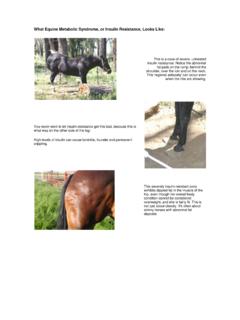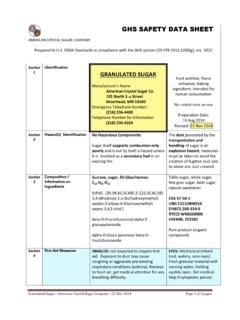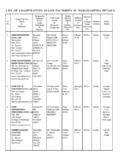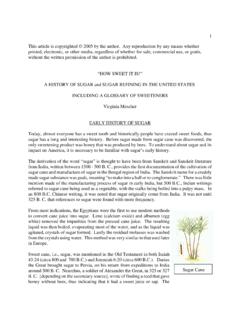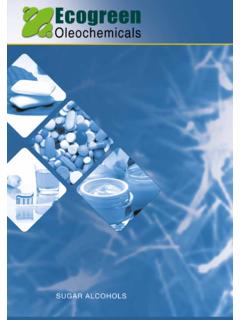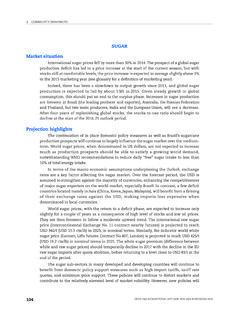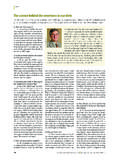Transcription of Testing for sugar/starch in feeds Glycemic carbs in …
1 Testing for sugar / starch in feeds Glycemic carbs in hay and feed Horses vary in their reaction to carbohydrates, and so there are no absolute numbers that can be considered safe for every laminitic or insulin resistant horse. Newly available tests for Ethanol Soluble carbs are probably the most important. Hopefully someday research will be done to help us know. ESC include glucose, fructose, sucrose, lactose and FOS, fructo-oligosaccharides, which are the very short chain fructans. FOS is very rapidly fermented, and apt to be the worst kind of fructan associated with abdominal distress. FOS also causes a Glycemic response (Bailey, 2007) ESC is a sub fraction of WSC. As per the Dairy One database grass hay averages about 8 % ESC(dm) (from a limited database) and 2% starch , for a total of average 10%dm Glycemic carbohydrates.
2 Less than 10%dm NSC (WSC + starch ) for hay or feeds has proven over the years to be a good target for a horse in trouble. Any horse that has acute laminitis or very high insulin levels should certainly be at, or below these levels. My IR ponies were able to eat 8% sugar + starch hay free choice without gaining weight. Of course the same horse may do fine on higher sugar + starch hay if regularly exercised and kept at a fairly high level of fitness. This is only one of many factors in managing insulin resistant, laminitic animals, which includes exercise, prevention of mineral deficiency and appropriate hoof care, but I feel the most important one. Mine are not the only horses that have had major improvement in long-term laminitis by minimizing sugar and starch in the hay.
3 Does WSC matter? Some people theorize that longer chain fructans (found in WSC, but not ESC) don't matter to horses with insulin resistance. But too many horses seem to have high insulin when we disregard WSC. With no published clinical research on the affect of hay with different carbohydrate forms and levels on insulin resistant horses, our only alternative is to watch the reaction of our own horses. Water Soluble carbs contain sugars, fructans of all sizes,maybe with some glucans or pectin, depending on the plant species. If your horse has gas colic, diarrhea, or presented with laminitis along with colic and diarrhea, WSC become more significant. Frankly when I and other researchers ask around, we find that laminitis does not usually present with colic, making us believe that laminitis is really more about insulin and Glycemic response.
4 WSC + starch is closest to what plant scientists call NSC, and they never change their definitions. I still consider both WSC and ESC when making choices. Most labs keep samples for 30 days, so you can call and ask for additional tests within that time frame. WSC at Dairy One is an extra $5. The difference between WSC and ESC will be longer chain fructan, for the most part. Fructans are definitely a source of calories, so if you are needing a low calorie hay for an overweight horse, you need to include WSC in your decision making. Under cold, sunny conditions, some popular cool season grasses (and resulting hays) may have fructan making up 40-50% of the WSC. We don't know anything about how long chain fructan might affect a horse metabolically.
5 It's not likely this research will ever happen, because long chain fructan is difficult and time consuming to extract. The amounts necessary to dose a horse are just too expensive to obtain. Fermentation end products are lactate, which is used by the liver to make glucose in a process called gluconeogenesis. Hydrolysis by stomach acids may create fructose, which is easily converted to glucose by the body. If there is a chance that long chain fructan does affect glucose metabolism, caution is warranted. I am currently getting WSC, ESC and starch on all my forage analysis. As always, my horse'sreaction will determine how I redefine my decision making process about what to feed them. If any of you include WSC, ESC. and starch in your hay tests for your insulin resistant horses, please let me know how they fare on hays that are below 10 % ESC + starch , but above 12% WSC on a dry matter basis.
6 If soaking such hay improves your horses soundness, or causes softening of neck crests or weight loss then that hay is not appropriate for that horse when fed dry. We need a lot more data before we can completely disregard WSC. Don't ask me what level is appropriate for your horse. Your horse will always give you the best advice about what to feed him if you are very observant. Please let me know what your insulin resistant horse tells you about what levels of WSC or ESC+ starch are appropriate. Can I test fresh grass for sugar ? Yes, but it has to be handled and shipped differently. Here's a new article on that subject. NFC vs NSC. Some forage Testing labs are offering tests for Non Fiber carbs (NFC) or Non Structural carbs (NSC). This nomenclature is confusing especially when everyone seems to have a different definition for NSC.
7 These two terms are sometimes used interchangeably, however to be technically correct, they are not the same. This is also the reason why Dairy One has quit using the term 'NSC'. They still do the same tests plus the new ESC; they just don't use that term anymore. Nutritionists can't agree what it means. In order to interpret results from labs that test for carbs , you have to how the test was conducted, and what exactly they are Testing for. Only then can you interpret the test correctly. Beware: feed companies also use these terms interchangeably. When asking about carb levels in commercial feeds , asking specifically for starch and sugar content ( and the sugar test used) will hopefully eliminate confusion, unless they are purposely using confusion to their own benefit.
8 NFC by subtraction or calculation If you subtract crude protein, crude fat, NDF, and ash from the total amount of dry matter, the stuff left is NFC. Hence the equation is: NFC% = 100 - (CP+(NDF-NDICP)+Fat+ash). where CP=crude protein, NDF =neutral detergent fiber NDICP = neutral detergent insoluble crude protein. This is not a good method, because not all the 'stuff' leftover is sugar , fructan or starch . There's also pectin, which is not a problem for laminitic horses, and organic acids and things like glucan that we're not even sure if they are good or bad in a horse's gut. The protein fraction can also get bound to the carbohydrates, making the equation inaccurate. Because alfalfa has large amounts of pectin, comparing NFC by subtraction for alfalfa, or other feeds high in pectin, such as beet pulp and soy hulls to grass hay is like apples to oranges.
9 Not applicable. Beet pulp and soy hulls are our friends. Bottom line: if you really want to eliminate guessing, don't bother with Testing for NFC by calculation, and get sugar + starch by wet chemistry instead. sugar and starch by Wet Chemistry This really is a more precise test, and the only one I feel comfortable using for my own horses. The technique is more problematic, so I only trust certified professional labs with a good reputation to do it accurately. There are VERY few labs even offering it. Equi-Analytical, AKA Dairy One, Ithaca, NY does Water Soluble carbs (sugars, fructans, glucans and organic acids) plus Ethanol Soluble carbs (mostly sugars and very short chain FOS - Fructo-oligosaccharides) and starch . Rumen Fermentation Profile Lab, at WV Univ.
10 Cumberland Analytical, Maugansville, MD, also tests ESC and starch . The method involves extracting with hot water or 80% ETOH, and Testing for sugars. They put in a dye that reacts with sugar , and quantify by colorimetric assay. Then they add enzymes, incubate for a day or so to break the starches down to sugar , and do it again. ESC is really a more accurate test for the 'bad stuff'. Fair comparisons between different hays can only be made if using the same lab. Even some hays with no seed heads can test up to 6% starch when grown under heat or cold stress, so this should be included for all hay samples. Here is a wealth of information regarding sugar and starch content in various feeds . Testing sugar and starch by NIR: These tests will be inexpensive( less than $20) and will not include trace minerals.
